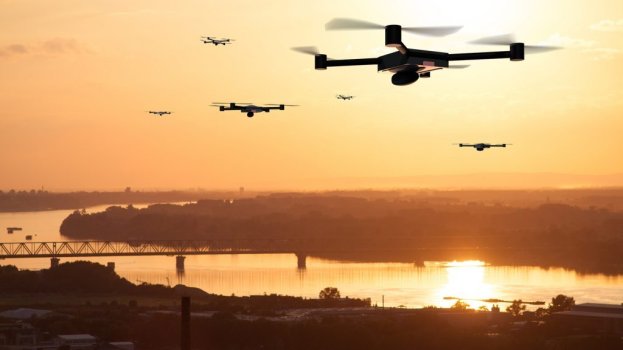K
Kathleen Martin
Guest
While challenges remain in incorporating the wide use of drone technology, RSS-Hydro is leading several innovative projects for the use of drones in water-based risk applications.
Many remote sensing technologies are present in both industry and academia – ranging from ground-based sensors to airborne and space-based platforms – measuring a very large amount of important environmental parameters for sustaining ecosystem services, environmental management, transportation, and weather, just to name some of the major fields of application.
Market opportunities of drones
One of the leading sectors where remote sensing, particularly ground-based and airborne, has seen major advances in the last few decades is agriculture. More recently, it has become one of the leading application sectors in the drone market. Drone technology was introduced into the sector more than two decades ago.1 Nowadays, the second and sixth biggest addressable markets for drone-based solutions are, respectively, agriculture (for crop monitoring), with an estimated potential value of $32.4bn, and the insurance industry (for risk monitoring and assessment), with an addressable market value of $6.8bn.2
Another application sector for drone-based solutions is emergency management, especially in the case of natural disasters such as floods. On the one hand, drones can be useful before a flood occurs by collecting lots of data on important infrastructure, and for supporting flood risk assessment efforts. On the other hand, drones can be useful after a flood occurs, for flood extent and damage assessment.3
Industry challenges
It is clear that drones are extremely useful and have great market growth potential; however, the use of drone technology comes with several challenges. These challenges are mainly faced in Europe, where the new regulations limit the use of drones, especially for drones that remain uncertified. The objective is to create a controlled environment and to increase safety while drones start to be used in a wide range of sectors due to a ‘thriving market’.4 As a consequence, flying drones, be it as an individual for private use or in a commercial setting, requires a range of precautionary measures in order to comply with regulations. Unfortunately, this can turn out to be much more complex than expected in some cases, particularly when looking at risk assessments or the specific category.
Therefore, national drone federations exist in many European countries and elsewhere, which aim to support companies during these procedures. The newest addition to this international federation network, is the Luxembourg Drone Federation (LDF), of which RSS-Hydro is a founding member. A major commitment of LDF is to help members develop a simplified flight authorisation procedure for operators. Therefore, LDF also acts as an intermediary between companies and the Luxembourg Department of Civil Aviation (DAC), by authorising flights in order to facilitate exchange and compliance. LDF also collaborates with the administrations of bordering countries.
Continue reading: https://www.innovationnewsnetwork.com/drone-technology-water-risk-applications/26780/
Many remote sensing technologies are present in both industry and academia – ranging from ground-based sensors to airborne and space-based platforms – measuring a very large amount of important environmental parameters for sustaining ecosystem services, environmental management, transportation, and weather, just to name some of the major fields of application.
Market opportunities of drones
One of the leading sectors where remote sensing, particularly ground-based and airborne, has seen major advances in the last few decades is agriculture. More recently, it has become one of the leading application sectors in the drone market. Drone technology was introduced into the sector more than two decades ago.1 Nowadays, the second and sixth biggest addressable markets for drone-based solutions are, respectively, agriculture (for crop monitoring), with an estimated potential value of $32.4bn, and the insurance industry (for risk monitoring and assessment), with an addressable market value of $6.8bn.2
Another application sector for drone-based solutions is emergency management, especially in the case of natural disasters such as floods. On the one hand, drones can be useful before a flood occurs by collecting lots of data on important infrastructure, and for supporting flood risk assessment efforts. On the other hand, drones can be useful after a flood occurs, for flood extent and damage assessment.3
Industry challenges
It is clear that drones are extremely useful and have great market growth potential; however, the use of drone technology comes with several challenges. These challenges are mainly faced in Europe, where the new regulations limit the use of drones, especially for drones that remain uncertified. The objective is to create a controlled environment and to increase safety while drones start to be used in a wide range of sectors due to a ‘thriving market’.4 As a consequence, flying drones, be it as an individual for private use or in a commercial setting, requires a range of precautionary measures in order to comply with regulations. Unfortunately, this can turn out to be much more complex than expected in some cases, particularly when looking at risk assessments or the specific category.
Therefore, national drone federations exist in many European countries and elsewhere, which aim to support companies during these procedures. The newest addition to this international federation network, is the Luxembourg Drone Federation (LDF), of which RSS-Hydro is a founding member. A major commitment of LDF is to help members develop a simplified flight authorisation procedure for operators. Therefore, LDF also acts as an intermediary between companies and the Luxembourg Department of Civil Aviation (DAC), by authorising flights in order to facilitate exchange and compliance. LDF also collaborates with the administrations of bordering countries.
Continue reading: https://www.innovationnewsnetwork.com/drone-technology-water-risk-applications/26780/

